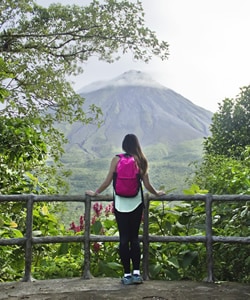Know how much it costs to travel to Costa Rica and enjoy its stunning natural landscapes, biodiversity, and vibrant culture. From lush rainforests teeming with exotic wildlife to pristine beaches lapped by azure waters, Costa Rica offers many experiences to suit every traveler’s taste and budget.
Discover several factors that influence the cost of traveling to Costa Rica, providing insights and tips to help you plan a memorable journey without breaking the bank. Whether you’re a budget-conscious backpacker or seeking a luxurious retreat, understanding the expenses can help you make the most of your Costa Rican adventure.
So, let’s uncover the true cost of experiencing pura vida in the Costa Rica tours.
FREE! Travel eBook to discover Costa Rica!
Grab the eBook with the exhaustive brochure for your Costa Rica Vacation All-Inclusive.
*By clicking send, you agree to receive information about products, services, promotions, or recommendations via email.
What is the Cheapest Time to Travel to Costa Rica?
Lo que vas a ver en este artículo
- 1 What is the Cheapest Time to Travel to Costa Rica?
- 2 How Much it Costs to Travel to Costa Rica: Factors Affecting Cost
- 2.1 1. Choosing the Best Time: Navigating Costa Rica’s Seasons
- 2.2 2. Where to Stay: Deciding on Accommodations in Costa Rica
- 2.3 3. Getting Around: Understanding Transportation Costs in Costa Rica
- 2.4 4. Culinary Delights: Budgeting for Food and Dining Expenses in Costa Rica
- 2.5 5. Budgeting for Activities and Excursions in Costa Rica
- 2.6 6. Understanding Exchange Rates and Currency for Your Costa Rica Journey
- 3 Navigating the Costs of Traveling to Costa Rica
The cheapest time to travel to Costa Rica largely depends on various factors such as weather, tourist seasons, and airline ticket prices. Generally, the rainy season, which runs from May to mid-November, is considered the low season for tourism in Costa Rica.
During this time, accommodation prices tend to drop, and you may find cheaper deals on flights and tours. However, it’s essential to remember that the rainy season can bring heavy downpours and humidity, which may not be ideal for some travelers.
Despite this, it can still be a fantastic time to visit if you don’t mind a bit of rain and want to save some money.
Another affordable time to travel to Costa Rica is during what’s known as the “shoulder seasons.” These are the periods just before and after the peak tourist seasons. In Costa Rica, the peak tourist seasons typically coincide with the dry season, which runs from mid-November to April.
The shoulder seasons, which fall in late November to early December and April to early May, offer a compromise between weather and cost. Compared to the peak season, you can still enjoy relatively dry weather with fewer crowds and potentially lower prices on accommodations and flights.
How Much it Costs to Travel to Costa Rica: Factors Affecting Cost
Several factors can influence the overall cost of traveling to Costa Rica. Understanding these factors can help travelers budget effectively and make informed decisions when planning their trips.
The time of year greatly influences the cost of traveling to Costa Rica, with peak tourist seasons typically correlating with higher expenses. Understanding the fluctuations in pricing throughout the year can help travelers make informed decisions about when to visit and how much it costs to travel to Costa Rica.
From mid-November to April, Costa Rica experiences its peak tourist influx during the dry season. This period coincides with the Northern Hemisphere’s winter months, attracting visitors seeking to escape colder climates.
Consequently, prices for accommodations, flights, and tours tend to be at their highest during this time. Hotel rates can skyrocket, especially in popular tourist destinations such as Manuel Antonio, Tamarindo, and Arenal. Similarly, airline ticket prices often see a significant markup due to increased demand.
Travelers may also pay a premium for activities and excursions as tour operators capitalize on the many visitors.
Conversely, the rainy season, also known as the green season, from May to mid-November, offers more budget-friendly options for travelers. While the prospect of frequent rain showers may deter some visitors, those willing to brave the weather can reap the benefits of reduced costs.
During this time, accommodations typically lower their rates to attract guests, making it possible to find discounted hotel rooms and vacation rentals. Airlines may also offer promotions and deals to encourage travel during the off-peak months.
Additionally, tour operators may offer discounts or special packages to entice travelers during the rainy season, allowing visitors to experience Costa Rica’s lush landscapes and vibrant wildlife at a lower cost.
The shoulder seasons, which occur just before and after the peak tourist periods, present another opportunity for budget-conscious travelers. In late November to early December and April to early May, crowds begin to thin out as the high season transitions into the low season.
Accommodation prices may start to decrease, offering a compromise between favorable weather conditions and affordability. Flights during these shoulder seasons can also be more reasonably priced than peak times, allowing travelers to enjoy milder weather without paying peak season premiums.
2. Where to Stay: Deciding on Accommodations in Costa Rica
Costa Rica’s accommodations offer various options to suit various preferences and budgets, influencing the overall cost of traveling to the country. Whether seeking budget-friendly lodging or luxurious retreats, Costa Rica accommodates every traveler’s needs.
For budget-conscious travelers, hostels, guesthouses, and budget hotels provide affordable options for accommodation. Hostel dormitory beds typically offer the most economical choice, ranging from $10 to $20 per night, making them ideal for solo travelers or those on tight budgets.
Private rooms in guesthouses or budget hotels offer more privacy while keeping costs relatively low, typically ranging from $20 to $50 per night, depending on the location and amenities. These budget accommodations are scattered throughout Costa Rica, allowing travelers to find affordable places to stay in popular tourist areas and off-the-beaten-path destinations.
Mid-range accommodations in Costa Rica cater to travelers seeking a balance between comfort and affordability. These options include mid-range hotels, bed and breakfasts, and eco-lodges, offering comfortable amenities and personalized service at reasonable prices.
This accommodations typically range from $50 to $100 per night, depending on location, seasonality, and facilities offered. Travelers expect clean and comfortable rooms, complimentary breakfast, and amenities like swimming pools, gardens, and onsite restaurants.
Costa Rica boasts a selection of upscale resorts, boutique hotels, and eco-luxury lodges for travelers seeking luxury and indulgence. These high-end accommodations offer unparalleled amenities, stunning natural surroundings, and personalized services for discerning guests.
Prices for luxury accommodations can vary widely, ranging from several hundred dollars to over a thousand dollars per night, depending on location, seasonality, and level of exclusivity.
Luxury resorts in Costa Rica often feature lavish accommodations, gourmet dining options, spa facilities, and a range of curated experiences, allowing guests to immerse themselves in the country’s natural beauty and rich culture.
3. Getting Around: Understanding Transportation Costs in Costa Rica
Transportation costs are a significant consideration when budgeting for a trip to Costa Rica, as they can vary depending on the mode of transportation chosen and the distances traveled within the country. Understanding the available options can help travelers plan their journeys while managing expenses effectively.
Public buses are one of the most economical ways to get around Costa Rica. The country’s extensive bus network connects major cities, towns, and tourist destinations, offering affordable fares for travelers.
Bus tickets typically range from a few dollars for shorter journeys to around $10 to $20 for longer routes between cities. Travelers can save even more money by opting for local buses, which serve smaller towns and rural areas at lower prices.
While public buses may take longer than other modes of transportation, they provide an authentic and budget-friendly way to experience Costa Rica’s landscapes and culture.
Renting a car is another popular option for travelers seeking flexibility and convenience during their trip to Costa Rica. Rental car prices vary depending on factors such as the type of vehicle, rental duration, and insurance coverage.
On average, rental car rates range from $30 to $100 or more per day, with additional costs for fuel, insurance, and optional extras such as GPS navigation or child seats.
While renting a car provides the freedom to explore remote areas and off-the-beaten-path destinations at your own pace, it’s essential to budget carefully and consider potential additional expenses when calculating how much it costs to travel to Costa Rica.
For travelers who prefer not to drive, private shuttles and taxis offer a convenient alternative for getting around Costa Rica. Private shuttles operate between popular tourist destinations, airports, and hotels, providing door-to-door transportation services for individuals and groups.
Prices for private shuttles vary depending on the distance traveled and the number of passengers, typically ranging from $50 to $200 or more per trip.
Taxis are also available in urban areas and tourist hubs, offering metered fares or fixed rates for specific routes. While taxis are more expensive than public buses, they provide a comfortable and hassle-free option for short-distance travel within Costa Rica.
If you want more information about Costa Rica, we invite you to read the next article: Fly to Costa Rica Cheap: How to Find Affortable Air Tickets.
4. Culinary Delights: Budgeting for Food and Dining Expenses in Costa Rica
Food and dining in Costa Rica offer a rich tapestry of flavors, with various options to suit every palate and budget. From traditional Costa Rican cuisine to international fare, travelers can indulge in a diverse culinary experience while exploring the country’s vibrant culinary scene.
This expenses play a significant role when considering how much it costs to travel to Costa Rica, but there are ways to enjoy delicious meals without breaking the bank.
For budget-conscious travelers, dining at local sodas and street food stalls provides an affordable way to sample authentic Costa Rican dishes. Sodas are small, family-run eateries that serve hearty and flavorful meals at reasonable prices.
Typical dishes include casados (a plate of rice, beans, salad, plantains, and a choice of meat or fish), gallo pinto (rice and beans), and ceviche (marinated seafood). Prices at sodas vary depending on the location and the type of dish ordered, but travelers can expect to pay around $5 to $10 for a filling meal.
Street food stalls offer quick and inexpensive snacks such as empanadas, tacos, and fresh fruit juices, making them convenient for travelers.
Mid-range dining options in Costa Rica include casual restaurants, cafes, and nightclubs, balancing affordability and quality. These establishments serve diverse cuisines, including Costa Rican specialties, international favorites, and fusion dishes.
Prices for meals at mid-range restaurants typically range from $10 to $20 per person, depending on menu selection, portion size, and location. Travelers can enjoy freshly prepared dishes made with locally sourced ingredients, accompanied by refreshing beverages and desserts, without exceeding their budget.
For travelers seeking a more upscale dining experience, Costa Rica boasts a selection of fine dining restaurants, gourmet eateries, and upscale cafes. These establishments offer innovative menus, exquisite presentations, and impeccable service, making them ideal for special occasions or indulgent meals.
Prices for fine dining experiences can vary widely depending on the restaurant, with average costs ranging from $20 to $50 or more per person for a multi-course meal with wine pairings.
While dining at upscale restaurants may be more expensive, travelers can expect a culinary journey filled with creative flavors, luxurious ingredients, and unforgettable dining experiences.
5. Budgeting for Activities and Excursions in Costa Rica
Activities and excursions in Costa Rica offer many opportunities for travelers to immerse themselves in the country’s stunning natural beauty and rich biodiversity. From thrilling adventures to serene nature walks, there’s something for everyone to enjoy while exploring this tropical paradise.
When considering how much it costs to travel to Costa Rica, factoring in expenses for activities and excursions is essential, as prices can vary depending on the type of experience and the provider.
One of the most popular activities in a Costa Rica vacation all-inclusive is eco-tourism, which allows travelers to explore the country’s diverse ecosystems and wildlife habitats while minimizing environmental impact.
Guided nature hikes through lush rainforests, national parks, and wildlife reserves offer opportunities to spot exotic wildlife such as sloths, monkeys, and tropical birds. Prices for guided nature hikes vary depending on the duration and difficulty of the hike, as well as the location and expertise of the guide.
On average, travelers can expect to pay around $30 to $50 or more per person for a half-day or full-day guided hike, including park entrance fees and equipment rental.
For adventure seekers, Costa Rica offers a wide range of adrenaline-pumping activities and outdoor adventures. Zip-lining through the treetops, whitewater rafting down raging rivers, and surfing along pristine beaches are just a few of the thrilling experiences available to travelers.
Prices for adventure activities can vary depending on the level of difficulty, safety standards, and equipment provided. While some activities may be more expensive than others, travelers can often find discounts or special deals by booking multiple excursions through tour operators or adventure companies.
Water-based activities such as snorkeling, scuba diving, and kayaking are popular for Costa Rica travelers. The country’s pristine coastline, coral reefs, and crystal-clear waters provide ideal conditions for exploring marine life and underwater ecosystems.
Prices for water-based activities vary depending on equipment rental, guide services, and transportation to and from the activity site. On average, travelers can expect to pay around $50 to $100 or more per person for a half-day or full-day snorkeling or diving excursion, including equipment rental and guide fees.
If you want to know more information, visit the official Costa Rica tourism website.
6. Understanding Exchange Rates and Currency for Your Costa Rica Journey
Exchange rates and currency considerations are crucial when budgeting for a trip to Costa Rica. As an international traveler, understanding how currency conversion works and monitoring exchange rates can significantly impact how much it costs to travel to Costa Rica.
Costa Rica’s official currency is the Costa Rican colón (CRC), although the US dollar (USD) is widely accepted throughout the country, particularly in tourist areas. When exchanging currency, travelers should be aware of the current exchange rates to ensure they receive a fair rate for their money.
Currency exchange services are available at airports, banks, hotels, and currency exchange bureaus, but rates and fees can vary widely between providers. It’s advisable to compare rates and shop around for the best deal to maximize your travel budget.
Travelers should consider potential exchange rate fluctuations and conversion fees when using US dollars in Costa Rica. While many businesses accept US dollars, they may offer less favorable exchange rates than colones, resulting in additional travel costs.
Additionally, using credit cards for purchases or ATM withdrawals in Costa Rica may incur foreign transaction fees and currency conversion fees imposed by banks or credit card issuers. You must check with your bank or credit card provider to understand the fees associated with international transactions.
Travelers can minimize currency exchange costs by using US dollars and Costa Rican colones, as well as local currency for smaller purchases and US dollars for larger expenses or emergencies.
Exchanging money at banks or ATMs typically offers better rates than currency exchange bureaus or hotels. However, travelers should be cautious when using ATMs in Costa Rica, as some machines may charge high withdrawal fees or have limited withdrawal limits.
When budgeting for a trip to Costa Rica, it’s essential to consider currency exchange rates and fees as part of your overall travel expenses. By monitoring exchange rates, researching currency exchange options, and minimizing transaction fees, travelers can optimize their travel budget and make the most of their money while exploring Costa Rica’s natural wonders and cultural attractions.
By considering these factors and carefully planning your trip, you can manage your expenses and make the most of your travel budget in Costa Rica.
Embarking to Costa Rica offers many experiences, from lush rainforests to pristine beaches, vibrant wildlife, and rich cultural heritage. However, understanding the costs of traveling to this tropical paradise is crucial for planning a memorable and budget-friendly trip.
As explored throughout this article, the cost of traveling to Costa Rica varies depending on several factors, including the time of year, accommodation choices, transportation options, food and dining preferences, activities and excursions, and currency exchange rates.
By carefully considering these factors and making informed decisions, travelers can maximize their travel budget and make the most of their time in Costa Rica.
By staying informed and planning strategically, travelers can embark on a memorable journey to Costa Rica without breaking the bank, creating unforgettable memories that will last a lifetime.
If you want more information about Costa Rica, we invite you to read the next article: When to Travel to Costa Rica: Navigating through the Seasons.























